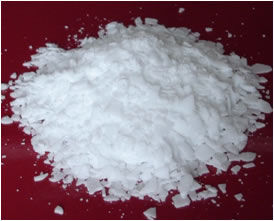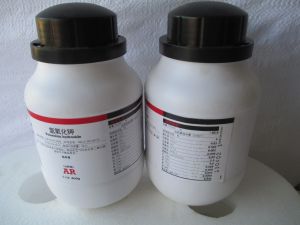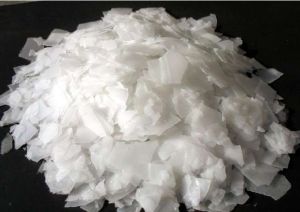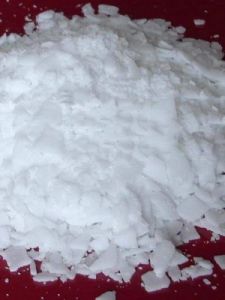Physical Properties
Chinese name: potassium hydroxide Chinese alias: caustic potash in English: Potassium hydroxide English aliases: Potassium hydroxide solution; caustic potash; potassium lye;; Potassium hydroxide; Potash; potassium: 1310 - 58- 3; 71769 - 53 - 4EINECS: 215 - 181 - 3 having the formula: H2KO Molecular Weight: 57. 113, for example, sodium hydroxide, potassium hydroxide KOH having the formula in the form of white crystals with saturated vapor pressure (kPa): 0. 13 (c)
719 that are soluble in water, ethanol, slightly soluble in ether and carbon dioxide can be absorbed by the deliquescent 719 that are soluble in water, ethanol, slightly soluble in ether and carbon dioxide can be absorbed by the deliquescent . .
its chemistry is similar to sodium hydroxide (caustic soda), an aqueous solution is strongly alkaline, which can destroy cellular tissues its chemistry is similar to sodium hydroxide (caustic soda), an aqueous solution is strongly alkaline, which can destroy cellular tissues . has 1, 2, 4 molecules of water of hydrate has 1, 2, 4 molecules of water of hydrate .
solid potassium hydroxide in water or water vapor generated by the heat of the flammable substance reaching the ignition temperature, and thus should be placed in a dry storage of the packaged solid potassium hydroxide in water or water vapor generated by the heat of the flammable substance reaching the ignition temperature, and thus should be placed in a dry storage of the packaged .
Chemical Properties
1. The reaction can be alkaline to litmus blue, and phenolphthalein TS to Red 2. reaction with an acid such as hydrochloric acid, sulfuric acid, nitric acid reaction
HCl + KOH KCl + H2O = H2SO4 + K2SO4 = 2KOH + 2H2O + KOH = KNO3 HNO3 + H2O 3. Reaction with acidic oxides such as carbon dioxide,sulfur dioxide reaction 2KOH + CO2 to K2CO3 + H2O = 2KOH + SO2 + H2O = K _ 2SO _ 4. The reaction with amphoteric metal such as aluminum is reacted with
2Al + 2KOH + 2H2O = KAlO2 + 3H2 5. uparw. and amphoteric oxide reaction such as reaction with alumina Al2O3 + 2KOH + H2O = 2KAlO2 6. reaction with amphoteric hydroxide Al (OH) 3 + KOH + 2H2O = KAlO2 7. with the transition element salt solution is carried out to reactDecomposition reaction of CuSO4 + 2KOH = Cu (OH) 2. dwnarw. + K2SO4 FeCl3 + 3KOH = Fe (OH) 3. dwnarw. + 3KCl except that potassium hydroxide may also occur as other reactions such as reaction with white phosphorus forms phosphine gas
1 1.
Main Uses
Industrial production is used as the inorganic potassium salts such as potassium permanganate, potassium nitrate, dipotassium hydrogen phosphate or the like of the raw materials are used for the manufacture of Industrial production is used as the inorganic potassium salts such as potassium permanganate, potassium nitrate, dipotassium hydrogen phosphate or the like of the raw materials are used for the manufacture of . havevide potassium soap, detergent, soap, shampoo and soft soap, vanishing cream, cold cream, shampoo and the like of the raw materials in pharmaceutical industry for the manufacture of progesterone havevide potassium soap, detergent, soap, shampoo and soft soap, vanishing cream, cold cream, shampoo and the like of the raw materials in pharmaceutical industry for the manufacture of progesterone .
, , . dyes and vanillin as raw materials for manufacture of melamine dyes and vanillin as raw materials for manufacture of melamine .
dye industry for the manufacture of an alkaline storage battery to dye industry for the manufacture of an alkaline storage battery to . used as saponification agents, carbon dioxide and moisture absorbers, analysis reagent, the alkaline agent (s);The article may be used as colour agent, metallurgical heating agent and in leather degreasing.used as a desiccant, absorbents, and also for plating, engraving, lithography, etc.;
Preparation Method
high - purity potassium hydroxide from the electrolysis of potassium chloride and aqueous solution of the electrolytic cell used in the form high - purity potassium hydroxide from the electrolysis of potassium chloride and aqueous solution of the electrolytic cell used in the form . and and .
sodium hydroxide production process which is similar to the use of a diaphragm electrolytic cell, the resulting electrolyte containing 10% ~ 15% (mass) of potassium hydroxide and from about 10% (mass) of potassium chloride sodium hydroxide production process which is similar to the use of a diaphragm electrolytic cell, the resulting electrolyte containing 10% ~ 15% (mass) of potassium hydroxide and from about 10% (mass) of potassium chloride . via evaporation, concentrating, cooling, most of the KCl crystallization separation is carried out to obtain potassium hydroxide 45% ~ 50% of the product (containing potassium chloride 0. 6%)
with a mercury electrolysis can be prepared in high purity potassium hydroxide,But should control the potassium chloride aqueous solution in the heavy metal impurity content of less than 1 ppm of chlorine in the hydrogen - containing gas to avoid too high with a mercury electrolysis can be prepared in high purity potassium hydroxide,But should control the potassium chloride aqueous solution in the heavy metal impurity content of less than 1 ppm of chlorine in the hydrogen - containing gas to avoid too high . using ion - exchange membrane electrodialysis to be used a dedicated ion exchange membrane to sodium hydroxide using ion - exchange membrane electrodialysis to be used a dedicated ion exchange membrane to sodium hydroxide .
difficult difficult . dehydration industrial solid potassium hydroxide having a purity of 88% to 92 mol%, solid block - shaped and has two sheet - like dehydration industrial solid potassium hydroxide having a purity of 88% to 92 mol%, solid block - shaped and has two sheet - like .
liquid potassium hydroxide 45% and 50% of the concentration of the two specifications liquid potassium hydroxide 45% and 50% of the concentration of the two specifications . 1, diaphragm electrolysis of potassium chloride in the raw material is molten into a saturated solution of salt bath, the mixture was heated to 90.d egree., respectively, when the addition of potassium carbonate, caustic potash, barium to remove calcium, magnesium and sulfate impurities, sedimentation and deslagging, hydrochloric acid, andrefined potassium chloride containing from 280 to 315 g / L of potassium chloride solution preheated to 70 - 75 DEG C and then performing electrolysis, potassium hydroxide, chlorine and hydrogen
diaphragm resulting potassium hydroxide having a concentration of 10% ~ 11%, desired clarification are concentrated by evaporation and cooling, containing 45% ~ 50% potassium hydroxide solution; may be performed under the boiling pot of water to concentrated, decolorized, solid potassium hydroxide, or potassium hydroxide into flaker to get flaky product diaphragm resulting potassium hydroxide having a concentration of 10% ~ 11%, desired clarification are concentrated by evaporation and cooling, containing 45% ~ 50% potassium hydroxide solution; may be performed under the boiling pot of water to concentrated, decolorized, solid potassium hydroxide, or potassium hydroxide into flaker to get flaky product . 2KCl + 2H O = = ₂ electrolytic ₂. uparw. + 2KOH + H Cl ₂ 2lt; ngt; 2,mercury electrolysis of the electrolytic solution was prepared in the same diaphragm electrolysis of the electrolytic chamber
in the graphite (or metal), which is the anode, a mercury cathode, electrolytically produced chlorine feeding chlorine drying process, generation of potassium amalgam mercury in the graphite (or metal), which is the anode, a mercury cathode, electrolytically produced chlorine feeding chlorine drying process, generation of potassium amalgam mercury . solution flows into the chamber most of the unreacted potassium chloride brine to the processed state, and it is returned to the raw material in the dissolving step ( solution flows into the chamber most of the unreacted potassium chloride brine to the processed state, and it is returned to the raw material in the dissolving step (.
potassium amalgam with water into potassium hydroxide solution and hydrogen potassium amalgam with water into potassium hydroxide solution and hydrogen . due to mercury chamber out of the potassium hydroxide concentration of 45% ~ 50%, as a liquid product may be potassium hydroxide, may also be through alkali boiling pot, evaporating into a solid caustic soda or potassium hydroxide is preferably in the form of a tablet product 3 due to mercury chamber out of the potassium hydroxide concentration of 45% ~ 50%, as a liquid product may be potassium hydroxide, may also be through alkali boiling pot, evaporating into a solid caustic soda or potassium hydroxide is preferably in the form of a tablet product 3 .
,potassium hydroxide prepared up industrially is the electrolysis of potassium chloride relative to sodium hydroxide aqueous solution ,potassium hydroxide prepared up industrially is the electrolysis of potassium chloride relative to sodium hydroxide aqueous solution . because of the hard - dehydration, as commercial products typically have a purity of only 85% ~ 86% because of the hard - dehydration, as commercial products typically have a purity of only 85% ~ 86% .
as desired can be purified according to purification methods of sodium hydroxide of the same purified as desired can be purified according to purification methods of sodium hydroxide of the same purified . 4, KCl and refining, preheated, and continuously injecting the electrolyzer, the electrolysis solution is concentrated, decolored 4, KCl and refining, preheated, and continuously injecting the electrolyzer, the electrolysis solution is concentrated, decolored .
5, ion - exchange membrane, to industrial potassium hydroxide was used as the anode chamber, cathode chamber as the pure substance, in dc field under the action of K + ions through the selective anode membrane into the cathode chamber and the OH - ions generated reagent potassium hydroxide, concentrated,. and then dried with solid KOH product gases O2, H2, respectively, by the tube discharge product gases O2, H2, respectively, by the tube discharge .
6, by means of a high - temperature heating calcium carbonate to calcium oxide, calcium oxide reacts with water to form calcium hydroxide, calcium hydroxide and potassium hydroxide with ash of CaCO3 = CaO + CO2 = High Temperature ₂. uparw. = ₂ H O + CaO Ca (OH) Ca (OH) ₂ ₂ ₂ K + CO =. dwnarw. + 2KOH CaCO
Safety Measures
Emergency Leakage Treatment
isolate the contaminated area surrounding set a warning flag, It's suggested that emergency treatment staff wear gas mask and chemicals protective clothing isolate the contaminated area surrounding set a warning flag, It's suggested that emergency treatment staff wear gas mask and chemicals protective clothing . do not directly contact the leakage, with a clearance of a shovel, are collected in a clean dry container with lid, a small amount to the addition of large amounts of water, or carbon dioxide or a weak acid, is adjusted to neutral, and then into the wastewater system do not directly contact the leakage, with a clearance of a shovel, are collected in a clean dry container with lid, a small amount to the addition of large amounts of water, or carbon dioxide or a weak acid, is adjusted to neutral, and then into the wastewater system .
may also be washed with large amounts of water, or carbon dioxide or a weak acid, a diluted washing water to the wastewater system may also be washed with large amounts of water, or carbon dioxide or a weak acid, a diluted washing water to the wastewater system . as a large amount of leakage, the collection or recovery and abandoning after innocuous treatment as a large amount of leakage, the collection or recovery and abandoning after innocuous treatment .
Protective Measures
Respiratory system protection: Wear a respirator when necessary Respiratory system protection: Wear a respirator when necessary . Eye protection: wear the chemical safety goggles Eye protection: wear the chemical safety goggles .
Clothing: Dress making (antiseptics) Clothing: Dress making (antiseptics) . Hand protection: wear rubber gloves (synthetic rubber) Hand protection: wear rubber gloves (synthetic rubber) .
Other: Take a shower after work; take care of individual hygiene Other: Take a shower after work; take care of individual hygiene . .
First Aid Measures
Skin contact: Take off the polluted clothes and use running water for at least 15 minutes Skin contact: Take off the polluted clothes and use running water for at least 15 minutes . .
hospitalizing Eye contact: Uplift the eyelids immediately. Wash completely with large quantity of flowing clean water or physiological silage for at least 15 minutes .
hospitalizing Inhalation: remove to fresh air quikly hospitalizing Inhalation: remove to fresh air quikly . .
keep respiratory tract unobstructed.Such as difficulty breathing, To oxygen.Such as breathing stops, conduct artificial respiration immediately hospitalized breathing stops, conduct artificial respiration immediately hospitalized .
. Ingestion: Rinse mouth with water. Drink milk or albumen
. hospitalized for fire - extinguishing method: use water and sand, preventing them from contacting with water splashing, Burns hospitalized for fire - extinguishing method: use water and sand, preventing them from contacting with water splashing, Burns .
emergency treatment: isolate the contaminated area,restricted access emergency treatment: isolate the contaminated area,restricted access . It's suggested that emergency treatment staff wear dust - proof mask (full mask) and acid - and alkali - proof coveralls It's suggested that emergency treatment staff wear dust - proof mask (full mask) and acid - and alkali - proof coveralls .
. Do not directly contact the leakage a small amount of leakage: collect the dust with clean shovel and hold in dry, clean and covered vessels Do not directly contact the leakage a small amount of leakage: collect the dust with clean shovel and hold in dry, clean and covered vessels .
may also be washed with large amounts of water, the diluted washing water into the wastewater system may also be washed with large amounts of water, the diluted washing water into the wastewater system . Severe leakage: collect and recover, or transport to waste fields for disposal Severe leakage: collect and recover, or transport to waste fields for disposal .
Chemical Information
Basic Information
Invasion ways: inhalation, ingestion, contact Invasion ways: inhalation, ingestion, contact . health hazard: this material has strong corrosive strongly stimulates respiratory tract after inhalation health hazard: this material has strong corrosive strongly stimulates respiratory tract after inhalation .
or or . cause burns to skin and eye contact may cause burns;oral burns to the digestive tract, cause burns to skin and eye contact may cause burns;oral burns to the digestive tract, .
lethal chronic effects: lung impairment, visual impairment, smell impairment lethal chronic effects: lung impairment, visual impairment, smell impairment . environmental hazards: resulting in water contamination environmental hazards: resulting in water contamination .
Explosive hazard: this product is inflammable, strong corrosivity and irritation, causing burns to human body Explosive hazard: this product is inflammable, strong corrosivity and irritation, causing burns to human body . dangerous properties: Its netralization reaction with acids emits heat not burn product dangerous properties: Its netralization reaction with acids emits heat not burn product .
, releases large amount of heat when contacting with water and vapor, forming corrosive solution with strong corrosiveness , releases large amount of heat when contacting with water and vapor, forming corrosive solution with strong corrosiveness . .
combustion (decomposition) product: generally no harmful products combustion (decomposition) product: generally no harmful products . acute toxicity: LD50273mg / kg (Rat Oral) irritation: rabbit eye: 1% severe acute toxicity: LD50273mg / kg (Rat Oral) irritation: rabbit eye: 1% severe .
percutaneous stimulation in rabbits:50 mg (24 hours), severe stimulation percutaneous stimulation in rabbits:50 mg (24 hours), severe stimulation .
Biological Data
1. Eco - toxicity TLm: 80 ppm (24h) (Gambusia affinis). 2. The biodegradable 3 No data. No data available non - biodegradable 4. Other deleterious effects due to alkaline, resulting in water pollution on plants and aquatic organisms should be given particular attention to
Molecular Structure Data
1, molar refraction: there are no available for 2, molar volume (m3 / mol): available without the 3, and the parachor (90. 2K): Not available 4, surface tension (dyne / cm): Not available 5, dielectric constant: there is no available 6, the polarization rate (10 - 24cm3): there is no available 7, monoisotopic mass: 55. 8 966447 Da, nominal mass: 56 9 Da, average quality: 56. 1056 Da
Calculation Of Chemical Data
1. A hydrophobic parameter to calculate a reference value (): No. 2. The hydrogen - bonding donor number: 1 to 1: 3. The hydrogen bond acceptor number: 1 to 1: 4. The number of bonds: 0 5. The number of tautomers: None 6. Topological Molecular polar surface area of 1, 7. heavy atom number: 2 to 8. The surface charge: 0 9. complexity: 10 2. isotopic atomic number: 0 11. determination of atomic number of stereogenic center: 0 12. does not determine the number of atoms to be stereocenters: 0 13. Determine a stereocenter chemical bond number: 0 14. determine the chemical bond is not a stereocenter number: 0 15. covalent bond unit number:2
Properties And Stability
1. deliquescent when exposed to air, which is easy to absorb moisture and carbon dioxide, the potassium carbonate deliquescent when exposed to air, which is easy to absorb moisture and carbon dioxide, the potassium carbonate .
gradually becomes soluble in water, dissolving the discharged heat of dissolution, hygroscopic, absorbing moisture in the air are dissolved and absorbed gradually becomes carbon dioxide gradually becomes soluble in water, dissolving the discharged heat of dissolution, hygroscopic, absorbing moisture in the air are dissolved and absorbed gradually becomes carbon dioxide . potassium carbonate dissolved in ethanol, slightly soluble in ether potassium carbonate dissolved in ethanol, slightly soluble in ether .
strong alkaline and corrosive, its nature and caustic soda can cause burns similar to strong alkaline and corrosive, its nature and caustic soda can cause burns similar to . .
tends to absorb moisture in the air and CO2 tends to absorb moisture in the air and CO2 . 2. The stability of the stable 3. prohibitors strong acids, flammable or combustible, carbon dioxide, anhydrides,acyl chloride 4. Avoid contact with the moist air conditions 5. Polymerization hazard without polymerization 6. potassium oxide decomposition products
Storage And Transport
1. Precautions for transportation: railroad, steel open wagon and available shipping packaging was complete when , , .
loading should be secure during transport to ensure that the container does not leak, did not collapse, did not fall, no damage to loading should be secure during transport to ensure that the container does not leak, did not collapse, did not fall, no damage to . process.Strictly forbid with the combustible or the combustible thing, acids, edible chemicals etc. mix to pack to mix a luck
transport when the transportation vehicle shall be equipped with emergency treatment facilities;2. Precautions for storage: This chemical shall be stored in a cool, dry, ventilated storehouse away from the tinder and heat sources ( away from the tinder and heat sources (.
humidity not greater than 85% humidity not greater than 85% . package should be hermetic and should not be affected with damp package should be hermetic and should not be affected with damp .
should be inflammable (combustible) chemicals, acids, etc. shall be stored separately, avoid mixed storage shall be prepared in storage area of the material suitable for accommodating leakage;3. Packaging method: solid may be loaded with 0.5 mm thick steel drums Yan Feng, the net weight of not more than 100 kilograms;Plastic bag or kraft bag full outer openings or openings in the drum;a threaded mouth glass bottles, iron - cap pressure bottles, plastic bottles or metal drums outside ordinary wooden crate;threaded glass bottle, plastic bottle or tub (tinplate) cans decorating the outside of tank bottom plate tracery, fibreboard or plywood box;tinplate barrel (tank), metal drums, plastic bottles, or flexible corrugated

